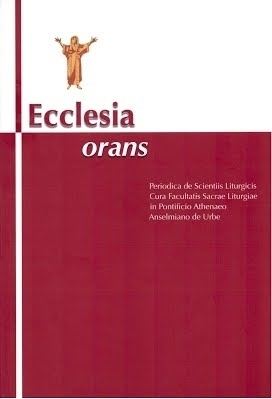 | ||
Ecclesia orans is liturgy scientific journal published by the Pontifical Liturgical Institute of Sant’Anselmo in Rome.
Periodica de Scientiis Liturgicis is the subtitle of the review.
Contents
Origins and frequency
Ecclesia orans was initiated in 1984. Next year was the time of the first issue that used to appear three times a year;
a reader was given 120 pages of Ecclesia orans the format of which was not changed from the beginning. Since 2013 it has been occurring twice a year.
Contents
Each time a reader can find articles on historical and literary study, liturgical theology and pastoral questions, publications concerning crucial liturgical affairs of the following kind: congresses, and noticeable publications on liturgy, and reviews of books. Pontifical Liturgical Institute life and activities are being described in a regular Newsletter. At the end of Ecclesia orans one can find a section of useful indexes: names, manuscripts, documents of the Church's magisterium, as well as liturgical, patristic and Christian authors sources, passages of euchology and songs, and the main index.
Characteristic
Both Ecclesia orans and the Pontifical Liturgical Institute of Sant’Anselmo in Rome are worldwide. There is a varied group of people that can contribute: the Liturgical Institute professors as well as other Faculties of the Athenaeum of Sant’Anselmo that come from different countries, the Liturgical Institute graduates, prominent liturgical scholars, and from writers who specialize in topics that are connected with the liturgy. One can read articles in the language of the writers: English, French, German, Italian, Portuguese and Spanish. The language that is used for editorial purposes is always English and Italian. Ecclesia orans, Periodica de Scientiis Liturgicis has now its own review that has been waiting for. Its twenty-two year experience and resources will help is an excellent tool to sanctify both men and women in Christ and worship God.
Relations with the Pontifical Liturgical Institute in Rome
Future liturgy professors, researchers, directors of liturgical commissions, and liturgical animators have been engaged with the formation by the Pontifical Liturgical Institute. In order to achieve its aim, the Liturgical Institute, raised to an Ecclesiastical Faculty in 1978 and organises courses so that students can be taught properly. Professors of the Liturgical Institute, for whom historical and theological approach to the liturgy is of vital importance. Not only formation of student is crucial for the Liturgical Institute but also books that are published to promote the liturgical sciences. The following volumes are in three volumes: Rerum Ecclesiasticarum Documenta, Analecta Liturgica, and Anàmnesis.
Principal objective
Another expression of the Liturgical Institute is Ecclesia orans, Periodica de Scientiis Liturgicis – its engagement is to extend the growth of the liturgy on a larger, international scale. The direction of the new review is to take is multi-faceted; a varied aspect of liturgy as follows: literary (editing and study of texts), historical, theological, pastoral, and artistic. What one will find special and original in the review is the scientific method and topic discussion. This is the way in which conciliar and postconciliar liturgical renewal can be led to scientific discussions. The Liturgical Institute will respond authoritatively to current issues of pastoral liturgy and to adapt to different cultures only provided that it builds on a solid scientific basis.
Other tasks
The review aimed to contribute to this process over the last 30 years; accepting various contributions to its pages strictly academic in nature, based on the research of their various authors, which is offered as a means to promote the science and technology needed to support a ritual celebration that is more committed and more aware of what he is doing. Among the objectives of the reforms of the Second Vatican Council and, before that, of the liturgical movement, was the intention to provide the necessary means for scientific research of the celebration of the liturgy, which could lead to a greater awareness of the reality that is celebrated. That is why, during the 19th and 20th centuries, different series and editions of sources have come into existence, especially patristic and liturgical sources, which over the years have become indispensable tools for the construction of a liturgical study and development of liturgical theology.
Strategy of the review
The strategy of this review with a strictly academic nature is determined by this principle: to provide a place for fellowship, discussion and reflection necessary to provide a serious theological ground on which to base the liturgical celebration. Therefore, Ecclesia orans has become an reliable voice, the echo of the Pontifical Liturgical Institute, which for more than 50 years of its life has promoted research on what the Tradition of the Church, in its more authoritarian forms, has given us. And it is in this line that the most important contribution of this first edition of 2013 has been included, the letter received by the editor of the magazine, from the emeritus Pope Benedict XVI.
